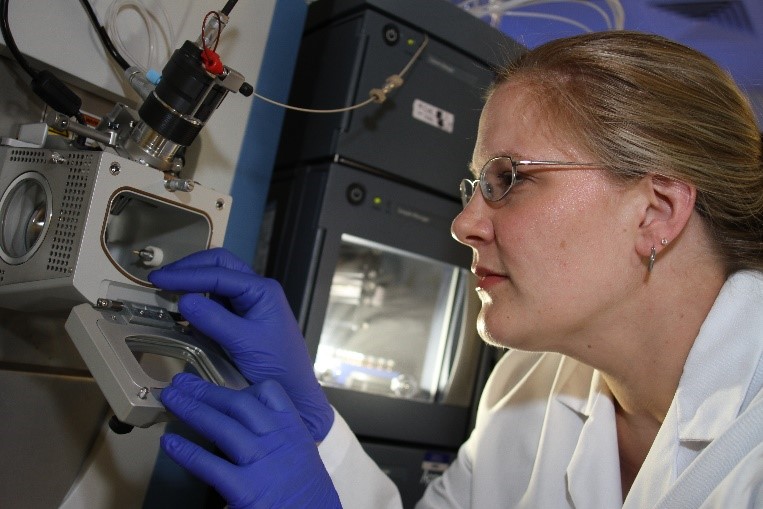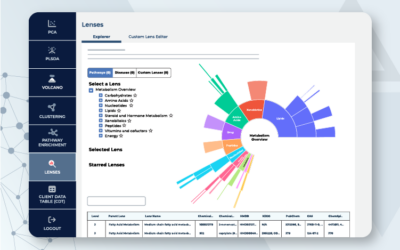When Annie Evans, Ph.D., first joined Metabolon, she had no idea of the breakthroughs she would be a part of, and how metabolomics would grow into an important ‘omics technology. “We’re impacting areas of the life sciences that I never thought possible,” she noted. After completing her Doctorate in Biological Mass Spectrometry at the University of Virginia, she joined Metabolon in 2004 as a research scientist. Early on, she was praised for her straightforward nature and presentation style, two things that played a crucial role in the development of the Metabolon we know now. Today, she is the Director of Research and Development.

Dr. Evans’ background in chemistry led to a fascinating discovery early in Metabolon’s history that may have otherwise gone unnoticed. The study involved a pharmaceutical company that wanted to pinpoint diagnostic markers of a drug that caused gut toxicity. The researchers ran plasma samples of drugs that were known to cause gut issues and some that did not.

Dr. Evans discovered a molecule that biologists deemed impossible to occur in mammals, but the presence of the molecule could not be denied. That is when metabolomics revealed that gut toxicity could be recognized through metabolites from the gut that passed into circulating plasma. What they were seeing for the first time were microbial derived metabolites in the blood, a discovery made 13 years ago. Even today, metabolomics is the only ‘omic able to identify gut microbiome activity in the blood.
Clinical metabolomics has the potential to make precision medicine a reality delivering transformational medicine. Traditional clinical testing of patient samples involves analyzing and measuring individual analytes or biomarkers. In the case of IEM’s, the screening method typically includes three panels, which measure in the range of 50-60 small molecules. Metabolon’s application of clinical metabolomics extends the number of biomarkers that can be measured significantly. Instead of 50-60, we can identify more than 500 small molecules, giving researchers a broader range of biomarkers to mine for insights.
The application of metabolomics is exceptionally significant for IEM and rare disease detection. There are hundreds of IEM diseases, and often the clinical manifestations of those diseases are vague, or the metabolic pathway that is disturbed is not immediately apparent. Applying global, or untargeted, analytical approaches, where prior knowledge of the affected metabolic pathway is not required, provides advantages over targeted analytical approaches and can extend the diagnostic potential of IEM screens beyond the 34-58 disorders that are currently evaluated in newborn screening programs, especially in complex cases. That makes throwing out this wide net to measure as many biomarkers as possible invaluable in a clinical setting.
When evaluating large quantities of information, it is paramount to make data quality a top priority. A critical step in drawing insights from untargeted metabolomics is accurate metabolite identification. Metabolon’s proprietary metabolomics workflow delivers Level 1-2 identifications for detected metabolites and uniquely provides high confidence in the identification of compounds. By contrast, most metabolomic practitioners operate primarily with annotations that only meet the standards of Levels 3-5, where some unique features are identified. Still, there is low confidence in confirming the metabolite. Data quality is extremely important to Metabolon, with exceptionally high standards applied to our work in clinical metabolomics. From start to finish, we emphasize quality control measures and checks and balances.
Metabolon’s method of clinical metabolomics is validated by Clinical Laboratory Improvement Amendments (CLIA), a regulatory standard for all testing of patient samples. Metabolon is ISO 9001: 2015 certified for analytical and diagnostic testing of biological specimens and accredited by the College of American Pathologists for diagnostic testing on human specimens. Additionally, Metabolon has a New York State Department of Health Clinical Laboratory permit to perform Quantose IR and IGT Glucose testing for the identification of insulin resistance and impaired glucose tolerance under the categories of Clinical Chemistry and Endocrinology.
In addition to the validation work we do to demonstrate the properties of the method, such as precision and accuracy, we also run the method under very specific quality control guidelines, which are even stricter than our research guidelines, including running batch controls for each of the analytic batches. We start by setting up the assays following policies that dictate how to establish a reference population, how you qualify the normalizing matrix, and so on. The typical regulatory requirements for review of the results is exceeded, with an additional analytical and lab director review in addition to our typical sub-level review. All of these steps ensure data quality and accurate insights.
In the early 2000s when Metabolon was formed, there were very few metabolomics practitioners. In fact, the term “metabolomics” was not yet part of the common scientific language. The practitioners mainly composed of academic universities referred to the science as “metabonomics,” and primarily used Nuclear Magnetic Resonance (NMR) technology. Metabolon, on the other hand, focused on a mass spectrometry-based platform that delivered on a global scale. Metabolon ultimately decided to standardize its methodology on the use of LCMS because the company quickly noticed the short-comings of both GCMS and NMR technology in terms of specificity and sensitivity. By choosing LCMS, Metabolon was able to identify more compounds than NMR technology allowed, while also enabling greater processing speed and reducing process variability beyond what is possible with GCMS. While using LCMS in the study of metabolomics was less common at the time, this methodology has allowed Metabolon to maintain its focus on the biology and the meaning of its findings—to interpret and make sense of the data that is revealed.
In its early years, Metabolon employed fewer than 15 scientists who studied just 50 to 100 small molecules. Today, the company has more than 200 employees, has run over 10,000 projects and has identified more than 2,000 named molecules in human plasma from a database of over 5,300 biologically relevant compounds. This comprises the world’s largest metabolomics knowledgebase.
In addition to traditional metabolites, Metabolon’s library features more than 1,000 complex lipids, analyzed on the Lipidyzer™, which the company co-developed with Sciex in 2012.
Metabolon’s compound database is remarkable not only for its size, but for its quality. From the beginning, Metabolon adopted a validated identification methodology, which required the identification of a compound based on multiple orthogonal criteria to an authentic standard analyzed using the same methodology. Compound identification confidence levels were later described and formalized in Sumner et. al., as Levels ranging from 1 to 5 for each metabolite, with Levels 1 and 2 being of the highest level of confidence. In untargeted metabolomics, accurate metabolite information is the key step in separating noise from insight. Today, more than 85% of compounds in Metabolon’s library meet the Level 1 criteria. Though level rating is a critical part of confidence in compound identification, it is a difficult and expensive process that takes tremendous resources and experience to be successful. As a result, few other metabolomics service providers are able to deliver the same level of confidence in metabolite identification offered from Metabolon’s proprietary metabolomics solution.

Today, Metabolon remains committed to investing in and advancing leading-edge metabolomics technologies. This emphasis is improving the understanding of systems biology, enhancing identification of clinically relevant biomarkers, accelerating drug development, improving patient stratification and revealing new insights in the rapidly advancing field of microbiome research.
For Dr. Evans, each success is a motivator to make the science even better. Once the power of the science has been revealed, the reward motivates both her and other scientists to continue making it better for everyone who is involved. She remarks that each scientist has been heavily involved in the trajectory of the company, each playing pivotal roles to move the science and technology from the small lab they began in to where they are today. “How could you not just fall in love with any technology where you can take something that you love and really feel like you’re impacting people and improving lives,” Dr. Evans said.
More about Dr. Annie Evans:
Dr. Annie Evans leads the discovery metabolomics and lipidomics profiling research and development team at Metabolon, Inc. The metabolomics and lipidomics platforms developed under Dr. Evans have been the analytical basis for thousands of commercial studies from over 700 institutions since 2004. She has over 30 publications covering the analytical methodology as well as informatics, data processing requirements and approaches for global profiling metabolomics and lipidomics workflows. These publications have been cumulatively cited over 2000 times, with a foundational metabolomics methodology paper being cited over 650 times. These publications have spanned various technology journals such of the Analytical Chemistry and the Journal of Chromatography, biological journals such as Blood and PNAS as well as high impact journals such as Nature Genetics. Dr. Evans currently holds an h-index of 35, with a JCR of 13. She is involved in industry establishment of quality control methods through the National Institutes of Health Metabolomics Quality Assurance & Quality Control Consortium (mQACC).




